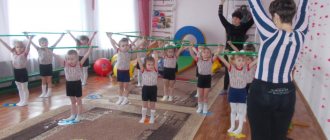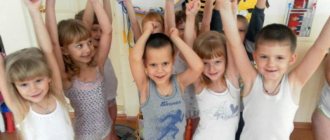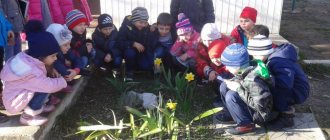Choosing the type of children's gymnastics
Health is unthinkable without movement. And if it is sometimes difficult for us to persuade ourselves to do exercises once again, then children are happy to do it themselves. Once a child starts walking, there is no stopping him. The baby continuously explores the world around him through sight, hearing, taste, smell and touch.
In the first months of life, the child is limited in movement and cognition. But the more varied the movements, the more varied the information obtained through them. So the mental development of a child directly depends on his physical activity.
The dependence here is very simple: a) sedentary muscles, bones, ligaments and joints do not receive enough stimulation, as a result of which b) they do not acquire the tone necessary for further growth, which c) slows down the development of motor skills and abilities, and this leads to d) limitation of capabilities learn new things about the world.
Fortunately, we have gymnastics - it will help eliminate the baby’s lack of movement and create favorable conditions for his health and development. Gymnastics will also help maintain emotional contact between mother and baby. Mom's loving hands, her gentle strokes, her gentle voice when she reads nursery rhymes to the baby during classes - all this makes the baby very happy.
Infants can only participate in passive exercise programs. This:
1) gymnastics (physical exercises);
2) gymnastics on the ball;
3) aqua gymnastics.
You can read about massage, which is also considered a type of passive gymnastics, at this link. And here we will talk about why each of the listed types of gymnastics is interesting and useful.
Gymnastics is good for a wide variety of movements. Exercise improves appetite, digestion, sleep, deepens breathing (thereby developing the lungs), causes increased blood flow to the muscles, to the bones with which they are connected, which promotes their growth. They tone the body and give the baby a great boost of energy and joy. The baby learns to feel his body, understand its signals and be in harmony with his physical self.
Up to a year, it is advisable to precede gymnastics with your baby with a massage session. It warms up and prepares the muscles for stress during physical exercise, which will be the final stage of the massage.
The purpose of morning exercises
Morning exercises are physical exercises whose purpose is to increase the overall tone of the body. It gives you a boost of energy for the rest of the day. And your children's muscles become stronger.
From this we can conclude that its main purpose is to awaken your body and get a boost of energy for the rest of the day.
Gymnastics on the ball
Children of any age really enjoy exercises on the ball. But in infancy, in addition to the pleasure of activities, we can safely talk about their undoubted benefits.
- Reduce muscle hypertonicity;
- Improve the functioning of internal organs;
- Train the vestibular apparatus;
- Strengthens the muscles of the back, abdomen and limbs;
- Reduce discomfort during colic.
A set of exercises for children helps strengthen the back muscles, especially around the spine, making the spine strong and flexible. And this is the key to the normal functioning of the nervous system and the free distribution of nerve impulses throughout the body.
Basic principles of ball gymnastics
- Strengthening the back muscles - place the child on his stomach.
- Strengthening the abdominal muscles - place the child on his back.
- Strengthening muscles during an umbilical hernia - we place the child on his back.
- General relaxation of the child - usually on the stomach.
- Correction of muscles in case of asymmetry of muscle tone - tilting the ball in the direction where increased tone is observed.
The optimal diameter of the ball for practicing with an infant is 60–65 cm. In infants, in order to reduce increased tone, the ball is lowered slightly; in order, on the contrary, to tone the body, they inflate it tightly. Apart from those common to all types of gymnastics, there are practically no specific contraindications for exercising on a ball, with the exception of an unhealed umbilical wound. You can start classes as early as one month of age.
Don’t worry if at first both you and your baby feel a little unsure and tense: you both will quickly get used to it if you practice regularly and without forcing things.
You will be surprised how quickly your baby’s body will react to such activities: the results of exercises on the ball will be noticeable almost immediately. The baby will become more active, stronger, will no longer be afraid of changes in the position of his body, his sleep and appetite will improve, and he will receive a positive emotional charge.
Morning exercise tasks
Morning exercises can strengthen your child's muscle corset. In childhood, no matter how old he is, up to 15-16 years old. The formation of his bones and, accordingly, his muscles is underway. Therefore, it is very important that your child exercises. To prevent spinal curvature and other pathologies from developing.
Also, it strengthens the heart muscle. Normalizes breathing and increases performance. In addition, if your child is active enough, then in the very morning he will be able to spend his energy and then engage in calmer games.
Exercise technique
We hold the child’s legs from above, press them against the ball, and the other hand fixes the back. We make soft, rocking movements: back and forth, left and right, circular movements left and right. There is no need to tilt the child forward very much, more emphasis is placed towards the legs. As the child gets used to the ball, the amplitude can be increased. You can also make movements in two planes - back and forth and up and down at the same time. The same movements are performed on the back as on the stomach; they should begin no earlier than 3 months: back and forth, left and right, circular movements in one direction and the other.
- Baby on tummy. We place our hands on the baby's back and lightly press him against the ball. You can hold the baby by the back with your right hand, and use your left hand to fix the left leg in the area of the knee joint. We begin to slowly rock the baby forward, backward, in a circle, so that there is a slight vibration.
- In the same position, rock the baby towards you and away from you, with slight vibration if the baby is already holding his head.
- Baby on the back. We hold it with our hands by the stomach and in the shin area, or you can fix the tummy with your right hand, and the left leg with your left. Slowly, when swinging the ball towards us, we bend the baby’s legs at the knee joints, and when moving the ball away from us, we straighten it. Gently rock the child while lying on his back in a head down position. It’s good if the baby straightens his arms at the same time, this reduces the tone of the flexor muscles. Now we try to perform the same movement, first only with the right leg, then only with the left leg.
- The baby is on his tummy again. We hold his hands and rock him back and forth. Gradually raise the arms extended forward so that the baby lifts his chest away from the ball.
- In the same position, we hold the baby in the lumbar region with our right hand, and with our left we try to put him in the “frog pose”, spreading his knees wide. In this position, we rock forward and backward, creating vibration. This is not only relaxing, but also very beneficial for the development of the hip joints.
While practicing on the ball, talk to your baby, praise him, sing songs or tell jokes. If your child doesn’t like something or is already tired, stop classes and continue another time. The time for practicing on the ball is not strictly regulated. If you and your child enjoy it, do as much as you want throughout the day.
At what age can you send your child to gymnastics?
The minimum age to start training is 3-5 years. In order for a child to achieve success, it is optimal to start classes at the age of 4-6 years. To achieve success in professional sports, it is better to send your child to schools in large cities. The career of a gymnast is short, many end it by the age of 20, go into coaching or give up the sport completely.
The maximum age for starting professional sports is 6-7 years. After this, you can attend training to improve the child’s physical characteristics, but it is too late to establish yourself as a budding gymnast.
Aqua gymnastics
Children are very accepting of this relatively new method of physical development. You can start exercises at home, in the bathroom and make them the final stage after massage and gymnastics or a separate lesson.
Swimming from the first months of a child’s life is very useful not only for physical development, but also for strengthening the nervous system. The baby is immersed in an environment to which he is accustomed, and this gives him a feeling of psychological comfort. Exercises in water do not overload the child and are especially recommended for children with psychomotor development disorders or diseases of the musculoskeletal and nervous systems.
Swimming:
- strengthens the immune system;
- normalizes sleep;
- regulates metabolism;
- stimulates the gastrointestinal tract;
- saturates the blood with oxygen;
- trains the cardiovascular system;
- forms correct breathing;
- affects the nervous system.
The main thing in classes is their gradualness and systematicity. While the baby gets used to the procedure, you can be in the bathroom with him; usually both the adult and the baby get great pleasure from this.
Charging can be combined with hardening
It is best to finish the exercise with a water procedure - wiping, dousing or showering. But at the same time, it is necessary to strictly follow the rules of hardening: - All hardening procedures carried out must correspond to the age of the child. — Once you start, do hardening constantly, regularly, at the same time. — Introduce all changes in temperature and duration of the hardening procedure to the child’s body carefully and gradually. - Carefully monitor the child’s mood and well-being. If the baby does not like the procedure, it will be very difficult to accustom him to hardening. — Be sure to periodically consult with your pediatrician and discuss the baby’s physical condition with him. Conclusion
: it’s very easy to accustom kids to exercise – just structure the activities in the form of a game appropriate to the child’s age. Do exercises for all muscle groups with it and try to combine exercises with hardening.
Tags:
- Home workouts
- Morning
- Preschoolers
- Pupils
To leave a comment you must be an authorized user
Basic principles of aqua gymnastics
- Comfortable water temperature in the first lessons is 37 - 37.5 degrees, with a decrease in it by 3 degrees until the end of the first month of swimming, and another 2 degrees in the third. For those who are bolder: please remember that the temperature should not fall below 28 degrees - in this case we are talking about hardening.
- The air temperature in the bathroom is 20 - 22 degrees, the door is open. Classes are held 40–60 minutes after feeding and 30 minutes before it.
- Duration of classes - 5 - 20 minutes.
- Water should be without additives (potassium permanganate, essential oils, herbal decoctions, salt), since baths with these additives are therapeutic and are designed for a lying baby, and aqua gymnastics is a set of active exercises with a fairly intense load on the muscles, respiratory, and cardiovascular systems.
- During exercises in water, the baby's ears may become submerged in water; after exercise, do not forget to dry them.
- The duration of classes in water for babies under 4 months in addition to a general massage is about 5 minutes, for older children - up to 10 minutes.
- As an independent type of exercise, aqua gymnastics is carried out for 15 – 20 minutes.
- Contraindications are: open umbilical wound, skin diseases, poor health and mood of the child, acute respiratory viral and other infections in the active phase (exacerbations), acute period of encephalopathy, rapid increase in intracranial hypertension, convulsions, extreme prematurity of children (rapid cooling) and general contraindications related to the purpose of gymnastics and massage.
Exercises for preschoolers
These exercises can be included in a complex of morning exercises from the age of 3; they will not lose their relevance even at an older age.
- Pull-ups. We place our feet shoulder-width apart, arms along the body. Then we raise our hands up and reach for the ceiling. Next, place your left hand on your belt and stretch your right hand to the left. We repeat in the opposite direction. The exercise ends with bending and stretching both arms towards the floor. Repeat 5-6 times.
- Squats. Starting position: feet shoulder-width apart, hands at the waist. We do a squat, with our heels pressed to the floor and our arms straightened. Climb. Hands on the belt. Repeat 4-5 times.
- "Pedals." We lie on our backs, raise our legs and spin the bike. In another option, you can make “scissors” with your feet. Repeat 5-6 times.
Aqua gymnastics technique
You should start teaching your baby to swim slowly and calmly. At first, we try to develop swimming reflexes, which begin to fade after birth if the child does not swim. At first, we hold the baby with both hands: one hand supports the head and upper back, and the other supports the chest area (both on the back and on the stomach). Make sure that the child's body is in the water, maintaining a horizontal position.
Classes begin with sliding on the surface of the water (along the bath, figure eight) and rocking. Your baby's ears may be in the water; when swimming on your chest, support your chin to prevent water from getting into your mouth. When you notice the appearance of rowing movements, you can remove one hand. Now you only support the baby's head. This creates conditions for free movement of arms and legs when swimming in a position on the stomach and back.
If the baby enjoys exercising in the water, you can begin to teach him to hold his breath: pour water on the baby’s head and face with water taken from the bath with your hand. The baby will close his eyes and hold his breath for two to three seconds. Repeat 3-4 times at each lesson.
When the child is already sufficiently trained, learns to hold his breath and masters the skill of rowing with his hands, you can teach the baby to swim independently. But this is a topic for another conversation, but for now your main goal is to simply make friends with water.
The set of exercises we offer is designed to be performed independently at home.
- Backstroke. In this case, the adult supports the back of the child’s head with one hand, and the other hand is under his back. Linear, zigzag movements are made back and forth, with the legs pushing away from the edges of the bath.
- Swimming on your stomach. Until the child has learned to hold his head well, his head and neck are supported on both sides. Older children are supported in a prone position with one hand under the chin (like a “bucket”), and the body is held with the other hand.
- Sidestroke. The child's head and torso are placed on the forearm of one adult's hand, and the baby's hand is held with the other hand.
- Older children can walk and bounce in the bathtub with the support of an adult under their arms.
Don’t forget that the most important thing in aquagymnastics (like any other) is the combination of benefit and pleasure, so don’t try to do it “right,” listen to your baby’s wishes, improvise and just enjoy the minutes of such pleasant communication. If you are not overly tense, your movements will become soft and confident, the baby will not show anxiety, and the exercises will bring only positive emotions to both of you.
Article:
Exercise is not a boring “obligation”, but a fun and interesting activity for children of any age, which allows them to develop dexterity, coordination and muscle strength.
It also strengthens the immune system, because it is rightly said: “Movement is life.” It is unlikely that a child will like traditional “adult” boring exercises, so it’s worth coming up with something more interesting for the baby. Parents will have to use their imagination and make exercise a fun, exciting game. For example, not just walk on heels and toes, but walk “like a fox,” “like a bear,” “jump like a bunny.” Each exercise should be performed by the parent himself and should be done cheerfully, with excitement, in order to interest the baby. Rhymes help the child to better understand the exercises and make morning exercises more fun and interesting. Cheerful, upbeat music promotes a good mood.
Recharge while playing
For a two- to three-year-old child, play is the main activity. That is why exercises should be built in the form of an active game with a plot that includes three or four physical exercises-imitations. A cheerful tone, a joke, laughter, and the active participation of an adult in the game always captivate the child.
Small children are restless and cannot stay in the same position for a long time. Therefore, the starting positions when performing exercises must be diversified: practice standing, sitting, lying, on all fours, crouching.
The number of repetitions of movements is from 2-3 to 5-6. After difficult exercises, it is necessary to take short pauses for rest (30-60 seconds), giving them a playful form, for example, “the dog sat down to rest,” “the bear went to bed.”
For each child, you need to select the load individually and be sure to ensure that he does not get overtired and does not lose interest in the exercise game.
How do exercises differ for children of different ages?
Children three to four years old love play situations with clearly defined roles and a clear plot. Therefore, games are selected for them with simple and specific content, for example, “the geese went for a walk, the wolf scared them, and they ran home.”
At five or six years old, children develop a desire to compete with each other, so games for them need to be made more complicated and an element of competition introduced into them.
For children six to seven years old, games should contain the most varied and complex movements: running, climbing, jumping, and an adult should demand their correct execution and interest the child in the end result.
How long should you exercise?
Charging can include 9-11 exercises for all muscle groups. When performing exercises, you should alternate movements of the legs, arms, and torso. Exercises are repeated 6–10 times.
Depending on your health and age, the duration of morning exercises can be 10–15 minutes.
Charging can be combined with hardening
It is best to finish the exercise with a water procedure - wiping, dousing or showering. But at the same time it is necessary to strictly follow the rules of hardening:
All hardening procedures performed must be appropriate for the child’s age.
Once you start, do hardening constantly, regularly, at the same time.
Introduce all changes in temperature and duration of the hardening procedure to the child’s body carefully and gradually.
Carefully monitor your child's mood and well-being. If the baby does not like the procedure, it will be very difficult to accustom him to hardening.
Be sure to periodically consult with your pediatrician and discuss the baby’s physical condition with him.
Other types of children's gymnastics
So you have become acquainted with the most reliable and proven methods. However, there are several other types of gymnastics that parents may be familiar with: baby yoga, dynamic gymnastics and mom yoga.
In the first case, we are talking about the manual practice of getting rid of possible birth injuries in the first two weeks after the birth of a child, which is carried out only by a highly qualified specialist. The second is a set of acrobatic exercises aimed at correcting muscle tone and developing coordination and the vestibular apparatus; training takes place in special classes with an instructor. In the third case, we are talking about mother’s yoga classes in the presence of the baby with a small number of asanas, in which the baby can participate without experiencing any physical activity, but simply maintaining contact with the mother.
Thus, all these types of gymnastics cannot be done at home without preparation. If you are interested in these types of physical activity and are determined to try them, first consult with a pediatrician, neurologist and orthopedic surgeon, weigh the pros and cons, and take training from a certified instructor.
Movement is life! And great joy
We talked about the importance of physical activity in the first year of a child’s life and found out that gymnastics can minimize the negative consequences of movement deficiency in an infant. Movement is directly related to mental development at this age, since the baby receives basic information about the world through sensory channels of perception. Gymnastics in all its diversity gives impetus to the enrichment and expansion of these channels. And the more opportunities a child has to learn, the more complete the picture of the world is formed in his mind and the more successfully he will cope with the tasks that life will set for him.
No matter how you work out with your baby, no matter what type of gymnastics you choose for yourself, the main thing is that you remember why you started working out with your child. If there are indications for therapeutic massage, you should entrust the matter to the hands of a professional. If they are not there and you decide to practice at home, then this is because you want your baby to be healthy and happy.
Let home gymnastics be not only and not so much a good physical workout for your child, but a way to live wonderful moments of harmony, mutual understanding and quiet joy with your baby. We wish you and your baby health!
Article on our Yandex Zen channel
Children's exercises for children of different ages
If you start learning gymnastics from early childhood, then, most likely, in the future gymnastics will be perceived as an obligatory part of life. At the same time, it is important to correctly correlate the physical training complex and age.
1 year
The baby is not yet able to concentrate on one activity for a long time and is just learning to control his own body. Therefore, gymnastics is carried out for a short time, in a playful way and with the help of an adult. At an early age, exercise helps the baby to learn to sit independently, and later it helps to learn to crawl correctly and quickly.
The figure shows an example of such a complex for one year of age
By the age of one and a half years, you can add other movements:
- throwing the ball with two hands;
- make a “bicycle” with your legs with the help of an adult;
- walking along a narrow path and on an inclined plane;
- climbing through a hoop.
All movements should be presented in a playful, entertaining form so that they serve as a source of joy.
By the age of two, the baby will be able to make side turns from a standing position, jump on the spot, throw a ball into a basket or other target, and flap his arms “like wings.” Some of the exercises for children 2 years old can be done during a morning walk:
- climb up and down ladders;
- walk on a plank on the playground or along a chalk path;
- throw a ball at a target;
- run and jump.
2-3 years
For children 2-3 years old, it is very interesting to repeat the movements of adults, so it is better to do exercises for children 3 years old together with their parents. Class time at this age is 4-5 minutes. It is more interesting if the whole complex is carried out in the form of a game.
The figure shows an example of such a ball game complex:
The complex begins and ends with breathing exercises:
- Take a couple of deep breaths: inhale with the ball above your head, exhale in front of you.
- Moving your head up and down.
- Tilt down towards the ball.
- Bend to the sides with the ball raised above your head.
- Squats, you can hold the ball in your hands.
- Jumping on one leg, or, if the child has not yet mastered this skill, then on two.
- Running with knees raised.
- Normalization of breathing, 3-4 deep breaths.
4-6 years
Older preschoolers deftly control their own bodies, and they enjoy repeating quite complex movements after adults. Exercise for children 5 years old is also better done in a playful form, because play continues to be the main activity. The average duration of gymnastics is 8-10 minutes. Older preschoolers, like younger children, will do gymnastics in poetic form with interest; each movement is repeated 5-6 times.
The sequence will be like this:
- Exercises with a jump rope (grab the cord, calmly raise and lower your arms). On inhalation, the arms are raised, on exhalation, they are lowered.
- Bend over, holding a folded rope, hands up. The task is to touch the floor with the jump rope.
- Mill - rotation with hands back and forth.
- Turns left and right, hands on the belt.
- Squats.
- Lunges left and right.
- Jumping on two and one leg.
- Finish with breathing exercises. Take a deep breath, and as you exhale, make a long “kwaah.”
From the age of five, a preschooler becomes very dexterous and physically developed. And although one of the consequences of increased cognitive and physical activity is the crisis of 5 years, another side of development will be a large number of new skills. A five-year-old can easily be taught to ride a bicycle or rollerblade with pleasure. That is why for older preschoolers, daily exercise is simply necessary so that the muscles can cope with increased physical activity.
7-9 years
A morning physical education session will help a younger student feel more energetic, better adapt to school stress, and saturate the muscles with oxygen. Gymnastics is especially necessary for children who do not attend sports clubs. 10-15 minutes daily will be enough for the muscles to receive the necessary load and stretch.
A full complex consists of 12 exercises
It is good to do exercises accompanied by rhythmic music. At the same time, ensure correct posture and breathing so that the child does not hold his breath. Each exercise is repeated 8-10 times.
- Start by vigorously walking in place for about a minute.
- Alternate tilts of the head to the shoulder - 4-5 times in each direction. Make sure that the child does not make sudden movements and returns his head straight to its original position.
- One hand reaches up, the other down - stretch diagonally, repeat 8 times.
- Turn the body left and right, but the feet do not move.
- A mill with a tilted body 4 times in each direction. I.p. – the body is tilted forward, arms to the sides. Turns around the waist, while the arms remain in the same plane, the left hand reaches out to the right - and vice versa.
- Tilts with two hands touching, in turn, to each leg. To the left - they straightened up, to the right - they straightened up. Total – 8-10 tilts.
- Rising from a half-squat position, raising your arms up.
- Alternating straight leg raises with clapping underneath.
- Pushups.
- Turn the torso to the sides from a sitting position with straight legs, hands behind the head.
- Alternating straight leg raises from a sitting position.
- Jumping up with your arms raised.
The complex is completed with breathing exercises: from a standing position, while inhaling, slowly rise on tiptoes, count to 3, and lower your entire foot. As you exhale, bend down as low as possible, trying to touch your toes, count to 3, and return to the starting position.





